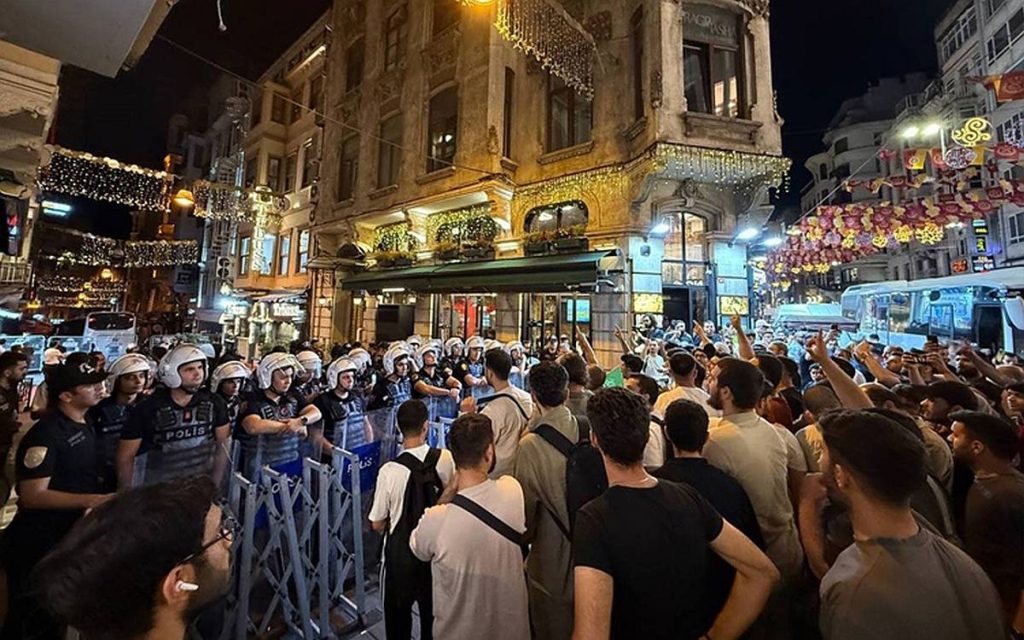A recent incident in Istanbul’s Beyoğlu district has sparked significant controversy and unrest. The office of the satire magazine LeMan was attacked after publishing a provocative cartoon that ignited accusations of insulting religious beliefs. Following the release of the cartoon, a criminal investigation was initiated, leading to public demonstrations that turned violent.
| Article Subheadings |
|---|
| 1) Background of the Controversial Cartoon |
| 2) The Government’s Response |
| 3) On-the-Ground Developments |
| 4) LeMan’s Defense and Statement |
| 5) Implications for Freedom of Expression |
Background of the Controversial Cartoon
The cartoon published in LeMan’s June 26 issue depicted two elderly figures identified as Muhammad and Moses flying over war-torn cities while missiles rained down. This image was intended to comment on the ongoing conflicts in regions such as Palestine, Israel, and Iran. The figures exchanged greetings in the cartoon, reflecting a complicated religious and cultural dialogue.
This artistic expression quickly drew the ire of conservative groups, who accused the magazine of disrespecting sacred beliefs, which escalated when the İstanbul Chief Public Prosecutor’s Office announced an investigation under Article 216 of the Turkish Penal Code. This law criminalizes the public denigration of religious values, setting the stage for public outrage and unrest.
The Government’s Response
In the wake of the cartoon’s publication and subsequent backlash, Justice Minister Yılmaz Tunç took to social media to voice his discontent. He labeled the magazine’s actions as derogatory and stated, “No freedom grants the right to make sacred beliefs the subject of vulgar humor.” His comments underscored a growing discomfort within the government concerning the boundaries of free speech, particularly when religious sentiments are involved.
Additionally, Interior Minister Ali Yerlikaya condemned the artwork, describing it as a “vile drawing.” In a concerning trend, the comments from high-ranking officials fueled tensions among the public, leading to a rapidly escalating response outside of LeMan’s office in Beyoğlu.
On-the-Ground Developments
Shortly after the public statements from government officials, a group gathered outside of LeMan’s office in Taksim. As tension rose, demonstrators began chanting religious slogans such as “Long live Sharia,” while simultaneously attempting to enter the magazine’s premises. Videos circulated showing them throwing stones and damaging the property, resulting in significant destruction.
According to reports from onlookers, the chaos extended beyond the magazine’s office, with attackers confronting patrons at nearby cafés and bars, leading to physical confrontations. Throughout this unrest, individuals were seen chanting religious slogans and portraying an organized effort to confront what they perceived as blasphemy.
In response to the violence, authorities implemented a 24-hour ban on public demonstrations in the Beyoğlu district, affecting all forms of public gatherings and protests. The district governor’s office stated that this measure was necessary to maintain order and prevent further escalation of violence following the attacks.
LeMan’s Defense and Statement
In the aftermath of the attacks and the investigation, LeMan issued a public statement defending their cartoon. The magazine argued that it did not intend to insult any religion, insisting that their primary goal was to highlight the suffering endured by oppressed Muslim communities, particularly in Gaza.
LeMan emphasized its historical editorial stance in support of Palestinian rights, underscoring that the cartoon was misinterpreted and that accusations of inciting religious hatred were unfounded. The magazine urged the Justice Ministry and other authorities to address those inciting violence under the guise of religious sensitivity, suggesting that their artistic expression was misrepresented in the heated discussions.
Furthermore, LeMan expressed regret to “well-intentioned readers” who might have felt hurt by the cartoon, reinforcing their commitment to responsible journalism while condemning violent actions taken by protestors.
Implications for Freedom of Expression
The conflict surrounding LeMan raises significant questions regarding freedom of expression in Turkey, particularly for artists and satirists. The swift reaction from the government reflects an ongoing tension between cultural sensitivities and the rights of individuals to express dissent or critique societal norms.
As governments globally wrestle with the backlash from artistic expressions that some view as offensive, it becomes critical to explore what boundaries, if any, should be established in these contentious discussions. LeMan’s case illustrates the potential repercussions for those who aim to challenge societal norms through satire and underscores the urgent need for dialogue about the boundaries of journalism and humor.
| No. | Key Points |
|---|---|
| 1 | The cartoon in LeMan sparked widespread outrage leading to a violent attack on the magazine’s office. |
| 2 | Government officials condemned the publication, citing it as a violation of religious sentiments. |
| 3 | A wave of public protest ensued, leading to significant property damage and confrontations outside the magazine’s office. |
| 4 | LeMan defended its work, emphasizing the intent to spotlight the suffering of oppressed communities. |
| 5 | The incident raises critical discussions about the limits of freedom of expression in artistic works. |
Summary
The violence following the publication of LeMan’s cartoon marks a pivotal moment for discussions around freedom of expression in Turkey. It emphasizes the delicate balance between artistic critique and societal values, necessitating a broader understanding of the implications that such confrontations have on individual freedoms and cultural discourse. This incident could serve as a catalyst for meaningful discussions surrounding the relationships between art, religion, and government interference.
Frequently Asked Questions
Question: What sparked the attack on LeMan’s office?
The attack was triggered by a cartoon published in LeMan that drew criticism for allegedly insulting religious values, leading to public outrage and violent protests.
Question: What actions did the government take in response to the situation?
The government officials condemned the cartoon and initiated a criminal investigation, while also imposing a ban on public demonstrations in the Beyoğlu district following the attacks.
Question: How did LeMan respond to the accusations?
LeMan defended its cartoon, stating it aimed to highlight the struggles of oppressed communities and rejected accusations of religious hatred, calling for action against those inciting violence.


